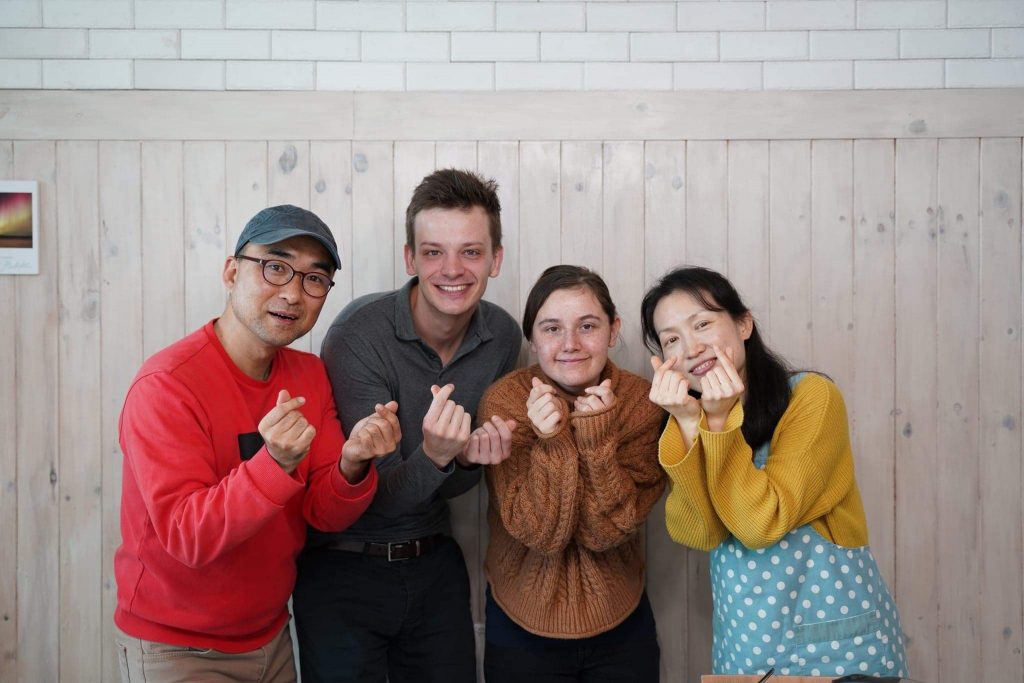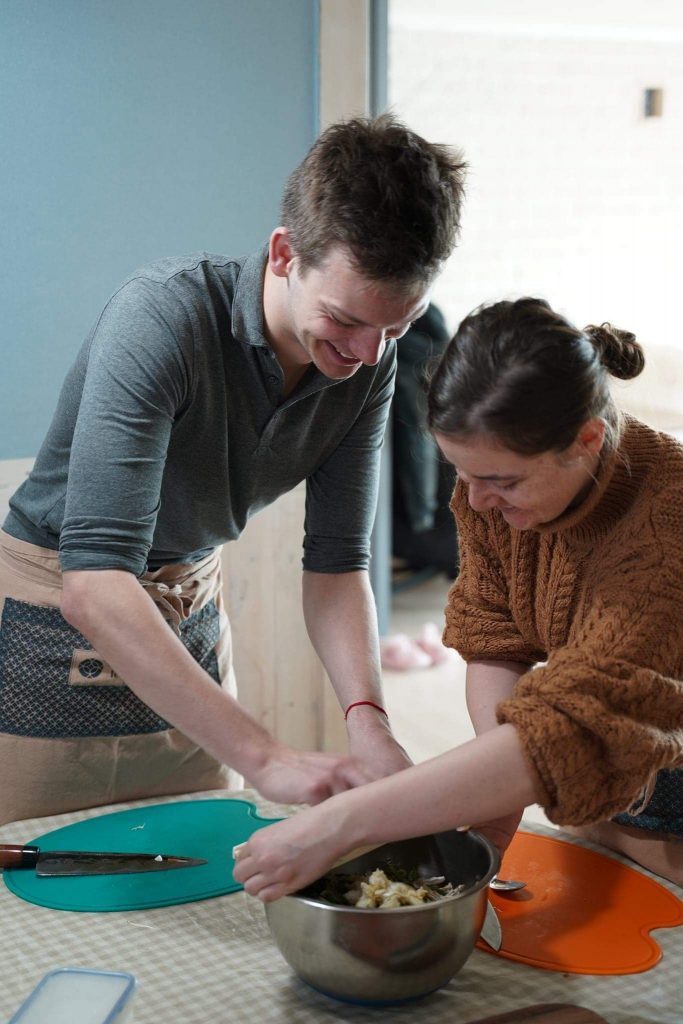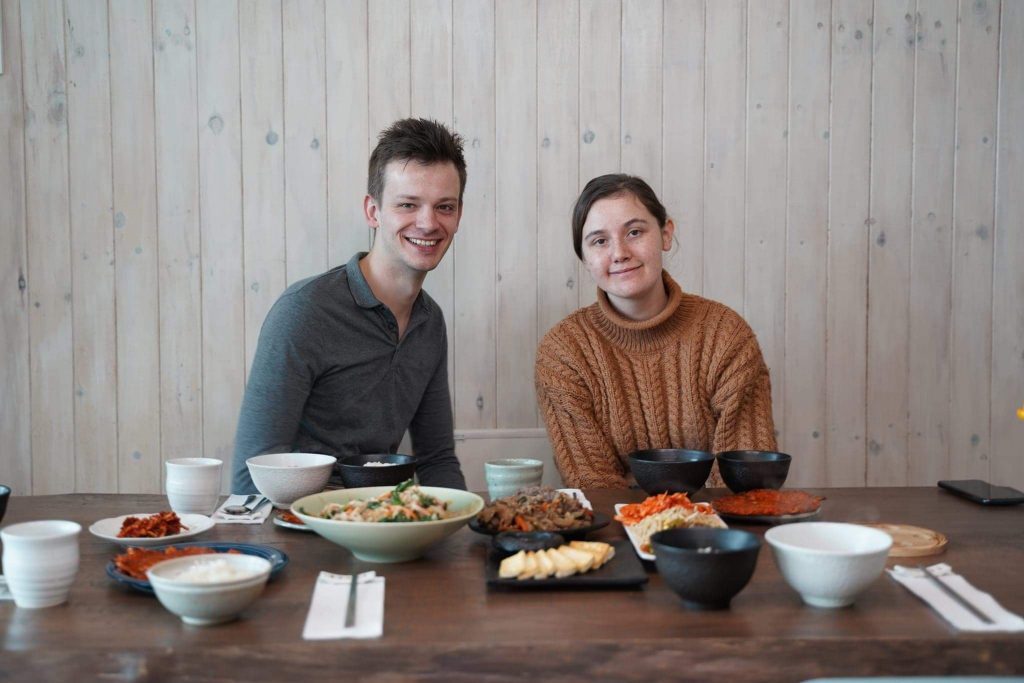Seoul Searching 4: Cooking like a Native

Unfortunately, I have never been skilled in the kitchen. I have been known to set off the fire alarm every time I fry an egg and despite eating pesto pasta twice a week, I can never remember how long fusilli needs to boil for. However, considering the fact I’m supposedly an adult, I figured it was about time I learned a few recipes and wow people with my South Korean cuisine. So, under the guise of a Christmas present for my partner, I booked a two-person cooking experience on Airbnb with a friendly-looking man named Hogan.
On the day of the experience, Hogan picked us up from the subway station and showed us the way to his home, the place where the cooking lesson would take place. At first glance, he was an averagely-built man with warm eyes framed by glasses. His black hair was covered by a cap which rounded off his face. He explained that he was a family man, happily married with two young children, all of which we would later meet.
When we arrived at their home, his wife, Seungok, opened the door to us and brightly welcomed us in with perfect English. Having stayed in a rural village for the majority of the year, this initially shocked us; however, we were glad that the language barrier would not be an issue as it had been in the past. Seungok, like her yellow jumper, was both cheerful and bubbly. Her frequent smiles set us at ease and quickly made us feel at home. Despite being a petite woman, she did not appear to be frail, having grown up on a farm, I suppose she must have developed both a physical and mental strength.

Their home gave off a contemporary vibe, the walls were panelled with pine with shelves built-in. They had an open plan kitchen which made the house feel larger and more communal. Hogan pointed to the long oak dining room table and beamed, “I made that myself”. When he wasn’t working or teaching foreigners how to cook, he spent his time doing woodworks or hiking with his family. It was impressive to see all the things he had made, and his self-sufficiency made me feel oddly motivated.
Taking a seat at the table, he handed us a list of all the dishes we would be cooking: Kimchi pancakes, bulgogi, japchae, sauteed tofu, fresh kimchi, soybean soup, and, of course, steamed rice. According to the pair, all of these recipes were staple Korean dishes and were beginner-friendly.
We started with steaming the rice in a slow cooker and preparing all the vegetables: cutting, slicing and dicing as per instructed. After this, we focused on the cold side dishes such as the fresh kimchi. For my non-Koreaboos, Kimchi is fermented cabbage which has been well-seasoned with a delicious – yet somewhat tongue-numbing – amount of spice. Typically, kimchi takes months to ferment; however, “fresh” kimchi (a name dubbed by Hogan for our ease of understanding) could be fermented in the space of a few minutes and had a lighter taste. First, we took some chopped cabbage and drizzled it in apple cider vinegar and fish sauce. Once it was sufficiently coated, we added sugar and chilli powder to give it some punch. Finally, we finished the dish off with sesame oil and toasted sesame seeds. Like kimchi, this dish is served cold alongside a few other sides.

Next, we made soybean soup which was quite possibly the easiest recipe I have ever seen. All you do is to season a pot full of water with salt, pepper, and some chilli powder, and then you add some soybeans or soybean paste (or both if you really want that beany taste!) We extracted a few cooked soybeans from the soup and left them to cool to be eaten with the fresh kimchi as a side.
Like Seungok, Hogan also grew up on a farm. As we prepared to cook, he explained that all his ingredients were sent over from his mother’s farm. He explained that his mother owned a farm down South and boasted that his mother makes the best soy sauce. Pulling out two unlabelled bottles, he poured a knuckles worth of sauce into two pots: “Try it,” he encouraged, “Which do you think is store-bought?” Testing the two, I noticed one tasted slightly sweeter and lighter, whilst the other had more of an artificial taste. After pointing this out, Hogan beamed “Exactly! The homemade one is much better quality”.
Laughing, he described how his mother makes the best sauces and how he tries to visit her often. He told us an anecdote from his previous visit: when looking through the cupboards, he found a large unlabelled bottle filled with a strong black substance. Inquisitive, he asked his mother what was in the bottle to which she cried “Soy sauce!”. She had left it to ferment before he was born but had misplaced it. 40-years later, the lost sauce had returned!
Moving onto a more complex dish, we prepared our japchae dish, which is simply stir-fried glass noodles with an assortment of vegetables and pork soaked in a hearty amount of sesame oil and homemade soy sauce. Whilst this recipe is also very student-friendly the only problem is the amount of mess it leaves: a pot from boiling the noodles, three pans (one to season the noodles, one to cook the pork, and one to fry the veggies) and then all the equipment used to initially chop the ingredients.
Once this was finished, we started my favourite recipe: Kimchi pancakes. To make kimchi pancakes you first need to slice a handful of kimchi and half an onion. Hogan explained that these needed to be sliced very finely, so they were long and thin, this would make it easier to pick them up with chopsticks. You then mix in ten spoonfuls of flour and one spoonful of 10% starch alongside a cup of water. The mixture should appear almost yoghurt like when mixed together. For good measure, I’d recommend adding a few heaps of chilli powder, so the pancakes retain the heat from the peppers. After you’ve thoroughly mixed the contents, you should add a thin layer to a well-oiled and well-heated pan, moving the pancake around so it doesn’t stick. When it has been flipped and is nice and bronze, you can serve it!
Next, we cooked a family-sized portion of bulgogi. The literal translation of bulgogi is “fire meat”, which is representative of both how it is cooked and its smoky taste. As the meat is quite thin, this makes it very tender and chewy. To cook this, we stir-fried thin slices of beef marinated in soy sauce, onion, garlic and a small touch of sugar to give it a slightly sweet taste. At the time, I joked about how much my dentist would hate me if she saw how much sugar I was cooking with and six months later, my joke was actualised. Turns out, while the sugar does make the food infinitely better, it does quickly decay your teeth – so be careful.
Finally, we quickly sautéed some tofu and beautifully arranged all the dishes on china plates. Seungok explained that the arrangement of the food is just as important as the cooking process itself. When looking at a meal, you are immediately put off by food that looks unappealing so you should always put lots of effort into the way you present your food. Similarly, as most meals in South Korea are communal, it is important to make the food accessible to everyone on the table.

After taking hundreds of food photos, we finally placed the rice in the centre of the table and sat down to eat. As we began to inhale the food, the couple took turns to ask us personal questions: Where are you from? What brought you to South Korea? Can you speak any Korean? The more we ate, the closer we became, discussing our countries political landscapes.
“Do you know why the rice goes in the middle of the table?” Hogan quizzed, “because it is the most important”. “Do you know how to ask, ‘how are you?’” he continued, “you ask if they have eaten rice yet. In the olden days, when our country was poverty-struck, if you had eaten rice, it was a good day and if they hadn’t eaten, you would offer them some”. I found the phrase quite touching and it reminded me of the relationship between food and culture – cooking is so much more than just following a recipe, it’s science, history, society, all rolled into one.

Recalling my own cooking experiences as I child, I wondered when my interest in cooking had disappeared. I used to adore baking and preparing food alongside my family, but as I grew older, I got busier and my love for cooking turned to resentment.
This realisation made me aware of the nonchalant way I have treated food in the past. By bunging things into the oven, I had treated food merely as a necessity rather than as a tool for understanding culture. In the past, I had thought of food as a means to an end when really it should be seen as so much more. Cooking is personal, every recipe has significance, it tells a story. Whether this is a story about a lost bottle of soy sauce or a cultural memory about rice.

Have a story to share? Contact us.
featherpen-blog@hotmail.com
Also, don't forget to follow us on Instagram!
@featherpenblog
Good to be going to your blog once more, it has been months for me. Nicely this article that ive been waited for so long. I require this write-up to total my assignment in the school, and it has same subject together with your article. Thanks, excellent share.
I just added this feed to my bookmarks. I really like reading your posts. Thanks!